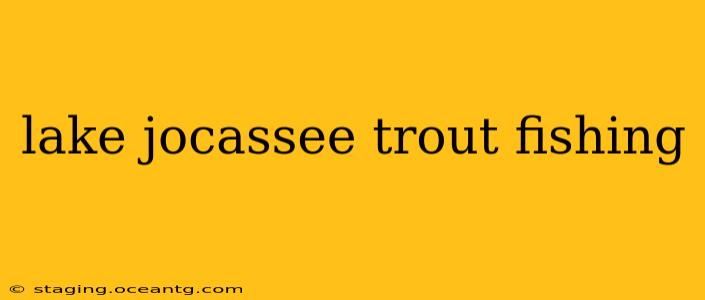Lake Jocassee, nestled in the pristine mountains of South Carolina, is renowned for its stunning beauty and exceptional trout fishing. This hidden gem offers anglers a truly unique and rewarding experience, but success requires understanding its unique characteristics. This comprehensive guide delves into the intricacies of Lake Jocassee trout fishing, providing you with the knowledge and strategies to maximize your chances of a memorable catch.
What Makes Lake Jocassee Trout Fishing So Special?
Lake Jocassee's crystal-clear waters, fed by pristine mountain streams, create a vibrant ecosystem perfect for trout. The lake's depth, coupled with its diverse underwater structure – including submerged forests and rocky shorelines – provides ample habitat for these elusive fish. The relatively low fishing pressure compared to other popular trout destinations adds another layer of appeal, resulting in larger, more challenging catches. The sheer beauty of the surrounding landscape only enhances the experience, making it a truly unforgettable angling adventure.
What Kind of Trout Can I Catch in Lake Jocassee?
Lake Jocassee is primarily known for its rainbow trout, often sizeable specimens exceeding 18 inches. However, you might also encounter brown trout, though they are less prevalent. The lake's cold, clear water is ideally suited to these species, fostering robust growth and healthy populations. The size and quality of trout in Lake Jocassee are a significant draw for anglers seeking a challenging and rewarding fishing experience.
What is the Best Time of Year to Fish for Trout in Lake Jocassee?
The best time for trout fishing in Lake Jocassee generally falls within the spring and fall months. During spring, the water temperatures are ideal for trout spawning and feeding activity. Autumn brings cooler temperatures and vibrant fall foliage, creating a beautiful backdrop for a memorable fishing trip. Summer fishing can be productive, but it requires understanding the trout's behavior in warmer water. Winter fishing can be challenging due to colder temperatures, but dedicated anglers can still find success.
What are the best lures and bait for Lake Jocassee trout?
Anglers find success employing a variety of techniques. Small spoons and in-line spinners are effective, mimicking the movement of baitfish. Streamers and nymphs are productive during the spring and fall when trout are actively feeding. The use of live bait such as small minnows or worms can also prove fruitful, particularly in areas with abundant natural cover. Remember to choose lures and bait that match the size and type of forage fish present in the lake.
What are the best fishing spots on Lake Jocassee?
Pinpointing the best fishing spots on Lake Jocassee requires local knowledge and experience. Exploring various coves, points, and drop-offs is key. Areas with submerged trees and rocky structures are likely to hold concentrations of trout. Talking to local guides or other anglers can prove invaluable in identifying productive fishing spots. Remember to always practice responsible fishing and respect the environment.
Are there any restrictions on fishing for trout in Lake Jocassee?
It's crucial to be aware of and adhere to all applicable fishing regulations and licensing requirements. These regulations are designed to protect the lake's valuable trout population and ensure its sustainability for future generations. Check the South Carolina Department of Natural Resources (SCDNR) website for the most up-to-date information on licensing, size limits, and creel limits.
What is the best technique for catching trout in Lake Jocassee?
There's no single "best" technique. Success often depends on factors such as water temperature, time of year, and trout activity levels. Experimentation is key. Try different techniques such as trolling, casting, and still fishing to discover what works best under specific conditions. A combination of approaches often yields the best results.
Lake Jocassee trout fishing provides a remarkable angling opportunity. By understanding the lake's unique characteristics, employing appropriate techniques, and adhering to fishing regulations, you can significantly increase your chances of a successful and memorable fishing trip. Remember to always prioritize conservation and responsible fishing practices to ensure the long-term health of this stunning ecosystem.
